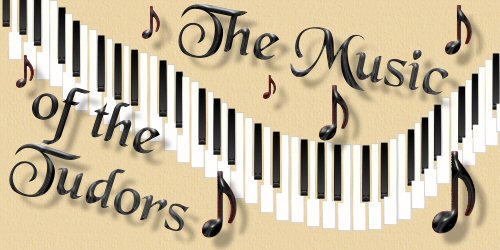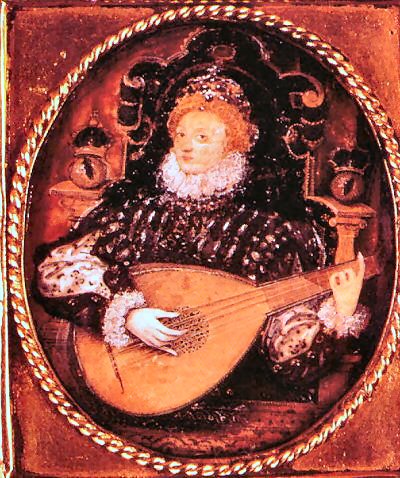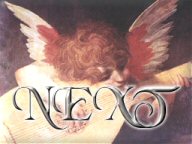| 

Henry was an accomplished musician and poet, as Shakespeare reminds us in the play Henry VIII: In sweet music is such art,
Killing care and grief of heart
Fall asleep, or hearing die.
(3.1.12-14) Henry VIII was a true renaissance prince. He was educated in the classics, and spoke and wrote several languages fluently, including the prerequisite Latin. He studied philosophy, and religion and often had heated debates with the learned thinkers of the age. He was an athlete and he was skilled in the arts of war. He wrote prose and poetry. But his real passion was always music. Henry VIII composed masses (which are now lost) and ballads. He played several instruments. And he amassed a considerable collection of them over his lifetime. As a matter of fact, when he died he left a collection that included 5 bagpipes, 78 recorders, 78 flutes, 10 trombones, 14 trumpets, & a mechanical virginal
Henry VIII loved luxury as well as music. His Chapel Royal consisted of 79 musicians alone. When he traveled he took some of the musicians along. Often that group included a choir of 6 boys and 6 men to sing daily mass. His full Chapel Royal, both clergy and musicians, attended him at the Field of the Cloth of Gold. Henry VIII had 10 trombonists which he used in churches to support the Plain Song of the Choir. 14 of 42 performers attached to Henry VIII played the trumpet.
Henry VIII introduced the custom of providing a drummer with drums carried in front of him on either side of his horse. This was an eastern custom introduced into Europe after the Crusades. The custom didn't reach England until the 16th century, however. Henry sent to Vienna in 1542 for drums that could be played on horse back. Henry VIII, a talented musician and composer himself, had access to a number of other talented musicians who played a variety of instruments. He often experimented with different combinations of those instruments. And by doing so could be said to have contributed to the development of the modern orchestra. Interestingly, there are a couple of songs whose lyrics are thought to have been written by Anne Boleyn. One of these is Defiled is My Name; the music was composed by Robert Johnson who may have been chaplain to Anne Boleyn in her final days. Another is Deathe Rock Me Asleep, also written in the Tower in her last days. All the Tudor offspring were musically trained from childhood, though none of them received any contemporary success for compositions as their sire had. Under the reign of Elizabeth music burst into its full flower in England; this era is often termed the “Golden Age of English Music�? Her patronage of music stemmed also from her courtly example as an able virginalist and lutenist, as well as an amatuer composer, singer and dancer. The French diplomat Hurault de Masse informed King Henry IV in 1598: "In her youth she danced very well and composed measures and music and had played them herself and danced them. She takes such pleasure in it that when her maids dance she follows the cadence with her hand and foot. She rebukes them if they do not dance to her liking and without a doubt she is mistress of the art, having learnt in the Italian manner to dance high."
By Shakespeare's time the music of the Church, the Court, and the stage had become sophisticated and varied, capable of communicating many moods. Virtually all plays--comedies and tragedies--used music to heighten the drama. England led the way in writing music for keyboard instruments. Towards the end of Elizabeth's reign the art of singing madrigals was introduced into England. In 1601, 21 Englishmen contributed to Thomas Morley's The Triumphes of Oriana, a collection in praise of Elizabeth.
As all forms of art, including music, the renaissance marked the rebirth of humanism, and a revival in cultural achievements for their own sake. Musical innovations were quickly disseminated, primarily facilitated by the advent of music printing, and thus the development of music theory and practice was likewise propelled forward. With the Renaissance, more complicated and broader harmonic structures emerged. Though the musical forms employed are still largely liturgical, the late Renaissance does see a great increase in sophistication for instrumental composition, as well as the emergence of secular madrigals, dramatic works and the first operas. The Renaissance is an important time period for modern music and musical instruments. Many styles and techniques came about in this time. More importantly, most of the instruments that we see today have evolved from instruments from the Renaissance. Instruments like the guitar, trumpet, trombone, flute, and oboe can all be traced back to more primitive counterparts of the Renaissance. Especially with wind instruments, there is a definite correlation to this time period. Most of the instruments were made out of wood, so in general there volume is quieter than the instruments of today. Some of the Renaissance instruments are the Shawm, Cornett, Recorder, Sackbut, and Flute. 
page graphix©ForeverAmber 2003©ALL MY TUDORS |  Free Forum Hosting
Free Forum Hosting